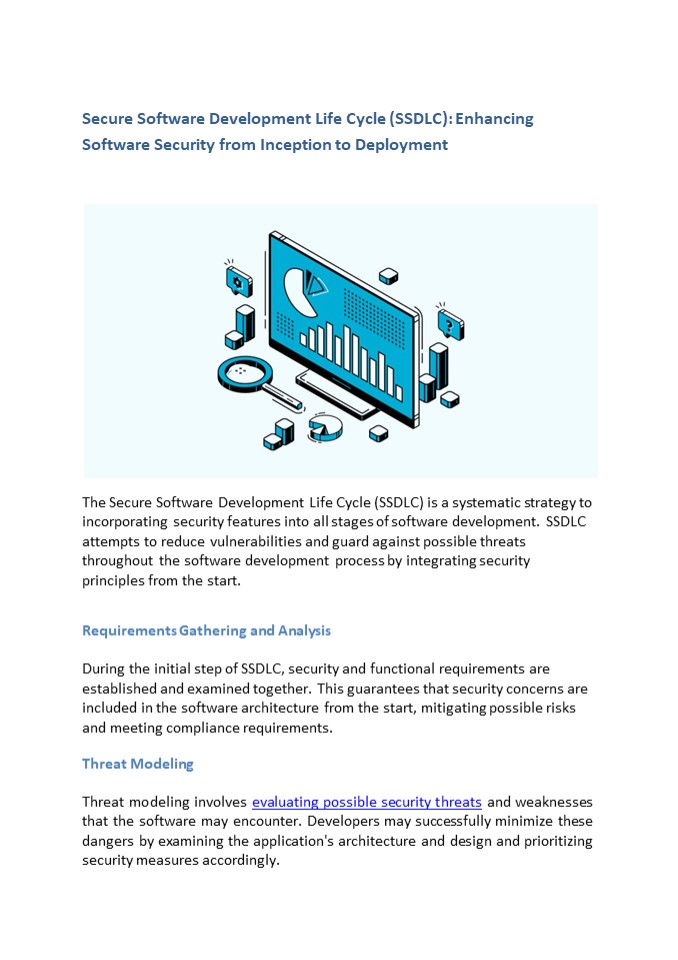Secure Software Development Life Cycle - PowerPoint PPT Presentation
Title:
Secure Software Development Life Cycle
Description:
The Secure Software Development Life Cycle (SSDLC) is a methodical approach that prioritizes security at every stage of software development. By integrating security measures from inception to deployment, SSDLC aims to mitigate vulnerabilities and safeguard against potential threats, ensuring the creation of robust and resilient software solutions. – PowerPoint PPT presentation
Number of Views:0
Title: Secure Software Development Life Cycle
1
Secure Software Development Life Cycle (SSDLC)
Enhancing Software Security from Inception to
Deployment
The Secure Software Development Life Cycle
(SSDLC) is a systematic strategy to incorporating
security features into all stages of software
development. SSDLC attempts to reduce
vulnerabilities and guard against possible
threats throughout the software development
process by integrating security principles from
the start. Requirements Gathering and
Analysis During the initial step of SSDLC,
security and functional requirements are
established and examined together. This
guarantees that security concerns are included in
the software architecture from the start,
mitigating possible risks and meeting compliance
requirements. Threat Modeling Threat modeling
involves evaluating possible security threats and
weaknesses that the software may encounter.
Developers may successfully minimize these
dangers by examining the application's
architecture and design and prioritizing security
measures accordingly.
2
Secure Design and Architecture During this phase,
developers incorporate security measures and best
practices into the software's design and
architecture. This comprises secure coding
standards, appropriate data encryption, access
restrictions, and authentication procedures to
protect sensitive information and prevent illegal
access. Secure Coding Practices Developers use
safe coding methods to create code that is
resistant to typical security vulnerabilities
like SQL injection, cross-site scripting (XSS),
and buffer overflows. This includes conforming to
code standards, validating inputs and outputs,
and avoiding unsafe coding practices. Code
Review and Static Analysis Regular code reviews
and static analysis techniques are used to find
security problems and vulnerabilities in the
codebase. This proactive strategy enables
developers to recognize and resolve
vulnerabilities early in the development process,
reducing the likelihood of security breaches in
the final product. Security Testing Security
testing uses a variety of methods and matrices,
such as penetration testing, vulnerability
scanning, and fuzz testing, to evaluate the
software's resistance to assaults. By replicating
real-world threats, security testing helps find
gaps and evaluates the efficacy of the
established security safeguards. Continuous
Integration/Continuous Deployment
(CI/CD) Integrating security into CI/CD pipelines
guarantees that security procedures are followed
consistently throughout the development process.
Automated security scans and tests are run as
part of the development and deployment processes,
allowing for quick discovery and resolution of
security vulnerabilities. Security Training and
Awareness Developers and stakeholders get
continual security training and awareness
initiatives to remain up-to-date on emerging
risks and best practices. This fosters a
security-conscious culture throughout the firm,
allowing personnel to identify and successfully
handle security concerns.
3
Incident Response and Remediation To address
security issues in a timely and effective manner,
a strong incident response strategy is developed.
This comprises methods for detecting, containing,
and mitigating security breaches, as well as
corrective activities to avoid future
occurrences. Post-Deployment Security
Monitoring Following implementation, constant
monitoring of the software is required to detect
and respond to security risks in real time.
Monitoring tools and procedures are used to track
system activity, discover abnormalities, and
respond to security events as they
arise. Conclusion To summarize, SSDLC provides a
complete framework for incorporating security
into the software development lifecycle.
Organizations that include security measures at
every level may proactively detect and reduce
security threats, protect sensitive data, and
foster confidence with stakeholders and users.































